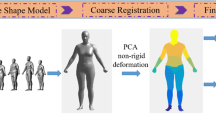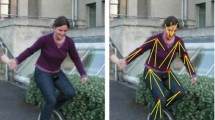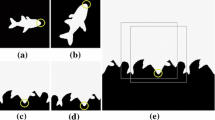Abstract
Consistent 3D human body segmentation plays a vital role in many human-oriented applications. Recently research used supervised methods to achieve state-of-the-art performance. However, requiring massive labelled data and tedious training is a costly process. Unsupervised methods do not need labelling and training but struggle to achieve consistent segmentation for a non-rigid deformable mesh. Moreover, the segmentation style is also fixed. In the paper, we aim to achieve high-performance, consistent 3D human mesh segmentation avoiding fully-labelled data and time-consuming training. Specifically, this paper designs a Laplacian operator by incorporating mesh saliency, in which a face-level filter is proposed to improve the detection of concave vertices. Accordingly, we construct a combinatorial descriptor by explicitly employing the global and local attributes derived from the spectrum of the proposed saliency Laplacian operator to achieve consistent segmentation in the spectral domain. An automatic determination mechanism is adopted to determine the number of segments. Extensive experimental results demonstrate that the presented method is effective and efficient for many 3D meshes, especially for the human body shape. The segmentation results are comparable to other state-of-the-art performances without requiring time-consuming labelling and training on large-scale datasets.




















Similar content being viewed by others
Data availability
Princeton Segmentation Benchmark (PSB) is downloaded from https://segeval.cs.princeton.edu/, and TOSCA dataset is downloaded from http://tosca.cs.technion.ac.il/.
References
Au OK-C, Tai C-L, Chu H-K, Cohen-Or D, Lee T-Y (2008) Skeleton extraction by mesh contraction. ACM Trans Graph 27(3):1–10. https://doi.org/10.1145/1360612.1360643
Benjamin W, Polk AW, Vishwanathan SVN, Ramani K (2011) Heat walk: robust salient segmentation of non-rigid shapes. Comput Graph Forum 30(7):2097–2106. https://doi.org/10.1111/j.1467-8659.2011.02060.x
Benzian MY, Benamrane N (2020) 3D Mesh Segmentation by Region growing based on discrete curvature. In: 2020 1st International Conference on Communications, Control Systems and Signal Processing (CCSSP), May 2020, pp 271–276. https://doi.org/10.1109/CCSSP49278.2020.9151831
Bronstein AM, Bronstein MM, Kimmel R (2006) Efficient computation of isometry-invariant distances between surfaces. SIAM J Sci Comput 28(5):1812–1836. https://doi.org/10.1137/050639296
Chang AX et al (2015) Shapenet: An information-rich 3d model repository. arXiv preprint arXiv:1512.03012
Chen X, Golovinskiy A, Funkhouser T (2009) A benchmark for 3D mesh segmentation. ACM Trans. Graph 28(3):73:1–73:12. https://doi.org/10.1145/1531326.1531379
Fang Y, Sun M, Kim M, Ramani K (2011) Heat-mapping: a robust approach toward perceptually consistent mesh segmentation. In: CVPR 2011, pp 2145–2152. https://doi.org/10.1109/CVPR.2011.5995695
Gauthier S, Puech W, Bénière R, Subsol G (2017) Digitized 3D mesh segmentation based on curvature analysis. Electron Imaging 2017(20):33–38. https://doi.org/10.2352/ISSN.2470-1173.2017.20.3DIPM-005
George D, Xie X, Tam GK (2018) 3D mesh segmentation via multi-branch 1D convolutional neural networks. Graph Model 96:1–10. https://doi.org/10.1016/j.gmod.2018.01.001
Golovinskiy A, Funkhouser T (2008) Randomized cuts for 3D mesh analysis. In: ACM SIGGRAPH Asia 2008 papers, New York, NY, USA, pp 1–12. https://doi.org/10.1145/1457515.1409098
Guo K, Zou D, Chen X (2016) 3D mesh labeling via deep convolutional neural networks. ACM Trans Graph 35(1):3:1–3:12. https://doi.org/10.1145/2835487
Hanocka R, Hertz A, Fish N, Giryes R, Fleishman S, Cohen-Or D (2019) MeshCNN: a network with an edge. ACM Trans Graph 38(4):90:1–90:12. https://doi.org/10.1145/3306346.3322959
He C, Wang C (2018) A survey on segmentation of 3D models. Wireless Pers Commun 102(4):3835–3842. https://doi.org/10.1007/s11277-018-5414-1
He Y et al (2021) Deep learning based 3D segmentation: a survey. arXiv:2103.05423 [cs], Mar. 2021, [Online]. Available: http://arxiv.org/abs/2103.05423. Accessed 26 July 2021
Hoffman DD, Singh M (1997) Salience of visual parts. Cognition 63(1):29–78
Hou Y, Zhao Y (2021) A robust segmentation algorithm for for 3D complex meshes. J Phys Conf Ser 1802(3):032045. https://doi.org/10.1088/1742-6596/1802/3/032045
Hou Y, Zhao Y, Shan X (2021) 3D mesh segmentation via L0-constrained random walks. Multimed Tools Appl 80(16):24885–24899. https://doi.org/10.1007/s11042-021-10816-0
Huang J, Kwok T-H, Zhou C (2019) Parametric design for human body modeling by wireframe-assisted deep learning. Comput Aided Des 108:19–29
Ji Z, Liu L, Chen Z, Wang G (2006) Easy mesh cutting. Comput Graph Forum 25(3):283–291. https://doi.org/10.1111/j.1467-8659.2006.00947.x
Jiao X, Wu T, Qin X (2017) Mesh segmentation by combining mesh saliency with spectral clustering. J Comput Appl Math, [Online]. Available: http://www.sciencedirect.com/science/article/pii/S0377042717302431. Accessed 16 July 2017
Jung JY, Chee S, Sul IH (2021) Automatic segmentation and 3D printing of A-shaped Manikins using a bounding box and body-feature points. Fashion Textiles 8(1):13. https://doi.org/10.1186/s40691-021-00255-8
Kalogerakis E, Hertzmann A, Singh K (2010) Learning 3D mesh segmentation and labeling. ACM SIGGRAPH 2010 papers, New York, NY, USA, pp 1–12. https://doi.org/10.1145/1833349.1778839
Kin-Chung Au O, Zheng Y, Chen M, Xu P, Tai C-L (2012) Mesh segmentation with concavity-aware fields. IEEE Trans Vis Comput Graph 18(7):1125–1134. https://doi.org/10.1109/TVCG.2011.131
Le T, Bui G, Duan Y (2017) A multi-view recurrent neural network for 3D mesh segmentation. Comput Graph 66:103–112. https://doi.org/10.1016/j.cag.2017.05.011
Lee Y, Lee S, Shamir A, Cohen-Or D, Seidel HP (2004) Intelligent mesh scissoring using 3D snakes. In: 12th Pacific Conference on Computer Graphics and Applications, 2004. PG 2004. Proceedings, Oct. 2004, pp 279–287. https://doi.org/10.1109/PCCGA.2004.1348358
Lee CH, Varshney A, Jacobs DW (2005) Mesh saliency. In: ACM SIGGRAPH, New York, NY, USA, pp 659–666. https://doi.org/10.1145/1186822.1073244
Levy B (2006) Laplace-Beltrami eigenfunctions towards an algorithm that ‘understands’ geometry. In: IEEE international conference on shape modeling and applications 2006 (SMI’06), p 13. https://doi.org/10.1109/SMI.2006.21
Lv J, Chen X, Huang J, Bao H (2012) Semi-supervised mesh segmentation and labeling. Comput Graph Forum 31(7):2241–2248. https://doi.org/10.1111/j.1467-8659.2012.03217.x
Mejia D, Ruiz-Salguero O, Cadavid CA (2017) Spectral-based mesh segmentation. Int J Interact Des Manuf (IJIDeM) 11(3):503–514. https://doi.org/10.1007/s12008-016-0300-0
Pal P (2012) Fast freeform hybrid reconstruction with manual mesh segmentation. Int J Adv Manuf Technol 63(9):1205–1215. https://doi.org/10.1007/s00170-012-3986-6
Rodrigues RSV, Morgado JFM, Gomes AJP (2018) Part-based mesh segmentation: a survey. Comput Graph Forum 37(6):235–274. https://doi.org/10.1111/cgf.13323
Rustamov RM (2007) Laplace-Beltrami eigenfunctions for deformation invariant shape representation. In: Proceedings of the fifth Eurographics symposium on Geometry processing, Goslar, DEU, pp 225–233
Shu Z, Yang S, Wu H, Xin S, Pang C, Kavan L, Liu L (2022) 3D shape segmentation using soft density peak clustering and semi-supervised learning. Comput Aided Des 145:103181. https://doi.org/10.1016/j.cad.2021.103181
Song R, Liu Y, Martin RR, Rosin PL (2014) Mesh saliency via spectral processing. ACM Trans Graph 33(1):6:1–6:17. https://doi.org/10.1145/2530691
Sun J, Ovsjanikov M, Guibas L (2009) A concise and provably informative multi-scale signature based on heat diffusion. Comput Graph Forum 28(5):1383–1392. https://doi.org/10.1111/j.1467-8659.2009.01515.x
Tao S, Huang Z, Ma L, Guo S, Wang S, Xie Y (2013) Partial retrieval of CAD models based on local surface region decomposition. Comput Aided Des 45(11):1239–1252. https://doi.org/10.1016/j.cad.2013.05.008
Theologou P, Pratikakis I, Theoharis T (2017) Unsupervised spectral mesh segmentation driven by heterogeneous graphs. IEEE Trans Pattern Anal Mach Intell 39(2):397–410. https://doi.org/10.1109/TPAMI.2016.2544311
Tong W, Yang X, Pan M, Chen F (2020) Spectral mesh segmentation via L0 gradient minimization. IEEE Trans Vis Comput Graph 26(4):1807–1820. https://doi.org/10.1109/TVCG.2018.2882212
Vasilakis AA, Fudos I (2014) Pose partitioning for multi-resolution segmentation of arbitrary mesh animations. Comput Graph Forum 33(2):293–302. https://doi.org/10.1111/cgf.12327
Wang H, Lu T, Au OK-C, Tai C-L (2014) Spectral 3D mesh segmentation with a novel single segmentation field. Graph Model 76(5):440–456. https://doi.org/10.1016/j.gmod.2014.04.009
Wang P, Gan Y, Shui P, Yu F, Zhang Y, Chen S, Sun Z (2018) 3D shape segmentation via shape fully convolutional networks. Comput Graph 70:128–139
Yamauchi H, Gumhold S, Zayer R, Seidel H-P (2005) Mesh segmentation driven by Gaussian curvature. Vis Comput 21(8):659–668. https://doi.org/10.1007/s00371-005-0319-x
Yang S, Wang R, Zhao W, Ke Y (2020) 3D intelligent scissors for dental mesh segmentation. Comput Math Methods Med 2020:e1394231. https://doi.org/10.1155/2020/1394231
Yi B, Liu Z, Tan J, Cheng F, Duan G, Liu L (2014) Shape recognition of CAD models via iterative slippage analysis. Comput Aided Des 55:13–25. https://doi.org/10.1016/j.cad.2014.04.008
Zhang L, Guo J, Xiao J, Zhang X, Yan D-M (2020) Blending surface segmentation and editing for 3D models. IEEE Trans Vis Comput Graph 28:1. https://doi.org/10.1109/TVCG.2020.3045450
Zhong Y, Li D, Wu G, Hu P (2018) Automatic body measurement based on slicing loops. Int J Cloth Sci Technol 30(3):380–397. https://doi.org/10.1108/IJCST-06-2017-0086
Zhou Y, Huang Z (2004) Decomposing polygon meshes by means of critical points. In: 10th International Multimedia Modelling Conference, 2004. Proceedings, Jan. 2004, pp 187–195. https://doi.org/10.1109/MULMM.2004.1264985
Funding
This work is supported by the Key Science and Technology Program of Henan Province, China [Grant No. 222102210124], National Natural Science Foundation of China [Grant No. 61572124], Key Program of Higher Education Teaching Reform Research and Practice, Henan, China [Grant No. 2021SJGLX167].
Author information
Authors and Affiliations
Corresponding author
Ethics declarations
Competing interests
The authors declare that they have no known competing financial interests or personal relationships that could have appeared to influence the work reported in this paper.
Additional information
Publisher’s note
Springer Nature remains neutral with regard to jurisdictional claims in published maps and institutional affiliations.
Rights and permissions
Springer Nature or its licensor (e.g. a society or other partner) holds exclusive rights to this article under a publishing agreement with the author(s) or other rightsholder(s); author self-archiving of the accepted manuscript version of this article is solely governed by the terms of such publishing agreement and applicable law.
About this article
Cite this article
Xie, H., Zhong, Y. Consistent 3D human body segmentation based on combinatorial descriptor in spectral domain. Multimed Tools Appl 82, 27927–27947 (2023). https://doi.org/10.1007/s11042-023-14729-y
Received:
Revised:
Accepted:
Published:
Issue Date:
DOI: https://doi.org/10.1007/s11042-023-14729-y




